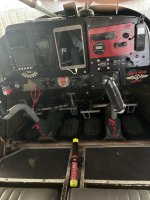OK…thoughts…..
I was a volunteer firefighter for twenty five years, and have used a LOT of different fire extinguishers in training and in anger. Dry Chems - forget about them for aviation (and I don’t really like them for anything, honestly). CO2 is nice under some circumstances - but way to heavy for aviation. Halon is my favorite in the cockpit - it works fast, its relatively lightweight, can be evacuated quickly after it puts the fire out, and yup - its what we used in teh space program where you COULDN’T open a window after the fire was out.
Think about mounting one under teh panel, on teh sidewall (hang it from the longeron, structurally), and if you smell electrical smoke, reach up, pull the pin, and squeeze the trigger - its already up under where the fire is suspected. If your passenger’s cigarette has started the upholstery on fire, reach up, pull the quick release, pull the extinguisher out and use it where its needed.
All due respect fr those carrying the “Element” - if you haven’t used it on a cockpit (or car cabin) fire, you really don’t know what you have - and you can’t stop it once you start it. I agree that the Internet YouTube videos of it look promising, but you know what you say about what you learn from the Internet……

. (This post, of course, brought to you on the Internet…..)


